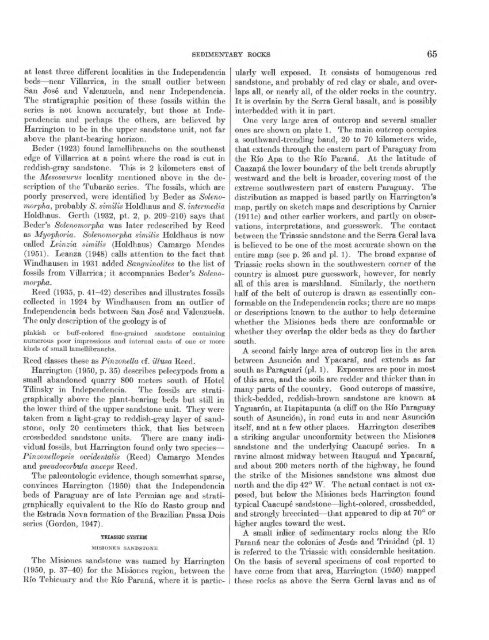Geology and Mineral Resources of Paraguay A Reconnaissance
Geology and Mineral Resources of Paraguay A Reconnaissance
Geology and Mineral Resources of Paraguay A Reconnaissance
- No tags were found...
You also want an ePaper? Increase the reach of your titles
YUMPU automatically turns print PDFs into web optimized ePapers that Google loves.
SEDIMENTARY ROCKS 65at least three different localities in the Independenciabeds near Villarrica, in the small outlier betweenSan Jose <strong>and</strong> Valenzuela, <strong>and</strong> near Independencia.The stratigraphic position <strong>of</strong> these fossils within theseries is not known accurately, but those at Independencia<strong>and</strong> perhaps the others, are believed byHarrington to be in the upper s<strong>and</strong>stone unit, not farabove the plant-bearing horizon.Beder (1923) found lamellibranchs on the southeastedge <strong>of</strong> Villarrica at a point where the road is cut inreddish-gray s<strong>and</strong>stone. This is 2 kilometers east <strong>of</strong>the Mesosaurus locality mentioned above in the description<strong>of</strong> the Tubarao series. The fossils, which arepoorly preserved, were identified by Beder as Solenomorpha,probably S. similis Holdhaus <strong>and</strong> S. intermediaHoldhaus. Gerth (1932, pt. 2, p. 209-210) says thatBeder's Solenomorpha was later redescribed by Reedas Myophoria. Solenomorpha similis Holdhaus is nowcalled Leinzia similis (Holdhaus) Camargo Mendes(1951). Leanza (1948) calls attention to the fact thatWindhausen in 1931 added Sanguinolites to the list <strong>of</strong>fossils from Villarrica; it accompanies Beder's Solenomorpha.Reed (1935, p. 41-42) describes <strong>and</strong> illustrates fossilscollected in 1924 by Windhausen from an outlier <strong>of</strong>Independencia beds between San Jose <strong>and</strong> Valenzuela.The only description <strong>of</strong> the geology is <strong>of</strong>pinkish or buff-colored fine-grained s<strong>and</strong>stone containingnumerous poor impressions <strong>and</strong> internal casts <strong>of</strong> one or morekinds <strong>of</strong> small lamellibranchs.Reed classes these as Pinzonella cf. Ulusa Reed.Harrington (1950, p. 35) describes pelecypods from asmall ab<strong>and</strong>oned quarry 800 meters south <strong>of</strong> HotelTilinsky in Independencia. The fossils are stratigraphicallyabove the plant-bearing beds but still inthe lower third <strong>of</strong> the upper s<strong>and</strong>stone unit. They weretaken from a light-gray to reddish-gray layer <strong>of</strong> s<strong>and</strong>stone,only 20 centimeters thick, that lies betweencrossbedded s<strong>and</strong>stone units. There are many individualfossils, but Harrington found only two speciesPinzonellopsis occidentalis (Reed) Camargo Mendes<strong>and</strong> pseudocorbtda anceps Reed.The paleontologic evidence, though somewhat sparse,convinces Harrington (1950) that the Independenciabeds <strong>of</strong> <strong>Paraguay</strong> are <strong>of</strong> late Permian age <strong>and</strong> stratigraphicallyequivalent to the Rio do Rasto group <strong>and</strong>the Estrada Nova formation <strong>of</strong> the Brazilian Passa Doisseries (Gordon, 1947).TEIASSIC SYSTEMMISIONES SANDSTONEThe Misioiies s<strong>and</strong>stone was named by Harrington(1950, p. 37-40) for the Misiones region, between theRio Tebicuary <strong>and</strong> the Rio Parana, where it is particularlywell exposed. It consists <strong>of</strong> homogenous reds<strong>and</strong>stone, <strong>and</strong> probably <strong>of</strong> red clay or shale, <strong>and</strong> overlapsall, or nearly all, <strong>of</strong> the older rocks in the country.It is overlain by the Serra Geral basalt, <strong>and</strong> is possiblyinterbedded with it in part.One very large area <strong>of</strong> outcrop <strong>and</strong> several smallerones are shown on plate 1. The main outcrop occupiesa southward-trending b<strong>and</strong>, 20 to 70 kilometers wide,that extends through the eastern part <strong>of</strong> <strong>Paraguay</strong> fromthe Rio Apa to the Rio Parana. At the latitude <strong>of</strong>Caazapa the lower boundary <strong>of</strong> the belt trends abruptlywestward <strong>and</strong> the belt is broader, covering most <strong>of</strong> theextreme southwestern part <strong>of</strong> eastern <strong>Paraguay</strong>. Thedistribution as mapped is based partly on Harrington'smap, partly on sketch maps <strong>and</strong> descriptions by Carnier(191 Ic) <strong>and</strong> other earlier workers, <strong>and</strong> partly on observations,interpretations, <strong>and</strong> guesswork. The contactbetween the Triassic s<strong>and</strong>stone <strong>and</strong> the Serra Geral lavais believed to be one <strong>of</strong> the most accurate shown on theentire map (see p. 26 <strong>and</strong> pi. 1). The broad expanse <strong>of</strong>Triassic rocks shown in the southwestern corner <strong>of</strong> thecountry is almost pure guesswork, however, for nearlyall <strong>of</strong> this area is marshl<strong>and</strong>. Similarly, the northernhalf <strong>of</strong> the belt <strong>of</strong> outcrop is drawn as essentially conformableon the Independencia rocks; there are no mapsor descriptions known to the author to help determinewhether the Misiones beds there are conformable orwhether they overlap the older beds as they do farthersouth.A second fairly large area <strong>of</strong> outcrop lies in the areabetween Asuncion <strong>and</strong> Ypacarai, <strong>and</strong> extends as farsouth as Paraguari (pi. 1). Exposures are poor in most<strong>of</strong> this area, <strong>and</strong> the soils are redder <strong>and</strong> thicker than inmany parts <strong>of</strong> the country. Good outcrops <strong>of</strong> massive,thick-bedded, reddish-brown s<strong>and</strong>stone are known atYaguaron, at Itapitapunta (a cliff on the Rio <strong>Paraguay</strong>south <strong>of</strong> Asuncion), in road cuts in <strong>and</strong> near Asuncionitself, <strong>and</strong> at a few other places. Harrington describesa striking angular unconformity between the Misioness<strong>and</strong>stone <strong>and</strong> the underlying Caacupe series. In aravine almost midway between Itaugua <strong>and</strong> Ypacarai,<strong>and</strong> about 200 meters north <strong>of</strong> the highway, he foundthe strike <strong>of</strong> the Misiones s<strong>and</strong>stone was almost duenorth <strong>and</strong> the dip 42° W. The actual contact is not exposed,but below the Misiones beds Harrington foundtypical Caacupe s<strong>and</strong>stone light-colored, crossbedded,<strong>and</strong> strongly brecciated that appeared to dip at 70° orhigher angles toward the west.A small inlier <strong>of</strong> sedimentary rocks along the RioParana near the colonies <strong>of</strong> Jesus <strong>and</strong> Trinidad (pi. 1)is referred to the Triassic with considerable hesitation.On the basis <strong>of</strong> several specimens <strong>of</strong> coal reported tohave come from that area, Harrington (1950) mappedthese rocks as above the Serra Geral lavas <strong>and</strong> as <strong>of</strong>
















